Official state symbols have long been a sign of pride and tradition in the United States. Each of the 50 states has its own unique collection of official symbols, such as a state flag, seal, flower, and song. Each state also has animals that have been chosen as official symbols of the state. Colorado legislators have chosen eight animals to represent their state. Let’s explore each one, along with how and why it was chosen to represent The Centennial State.
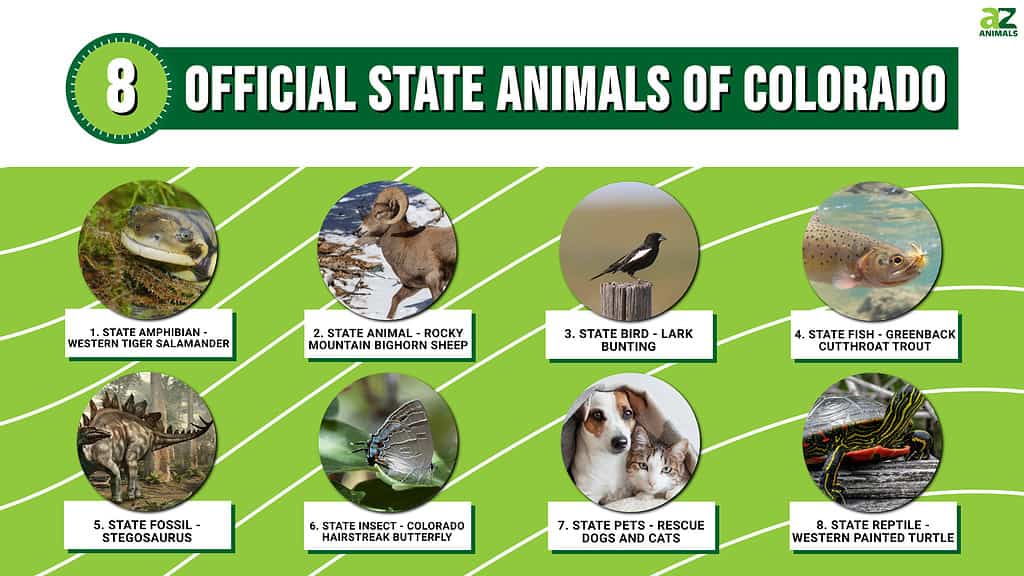
1. State Amphibian: Western Tiger Salamander
The western tiger salamander (Ambystoma mavortium) was designated as the official state amphibian of Colorado in 2012. The adoption of this salamander as the state amphibian came through the efforts of students from Steck and Westerly Creek Elementary, the Bill Roberts K-8 School, George Washington High School, and Stanley British Primary School.
These students selected the western tiger salamander, also known as the barred tiger salamander, as the candidate for Colorado’s state amphibian because it is found in all 64 counties in the state.
When the legislation was debated in the Colorado House of Representatives, a second candidate was presented for consideration as the state’s official amphibian: the northern leopard frog. The proposal was dismissed, however, because the frog is only found in 58 of Colorado’s 64 counties. The western tiger salamander was approved by the House, then by the Senate. Governor John Hickenlooper (D) signed the bill, and the western tiger salamander was officially designated as the state amphibian of Colorado on March 16, 2012.
The range of the western tiger salamander runs throughout the western United States, as well as southwestern Canada and northern Mexico. The salamander is almost always found near ponds, streams, or lakes.
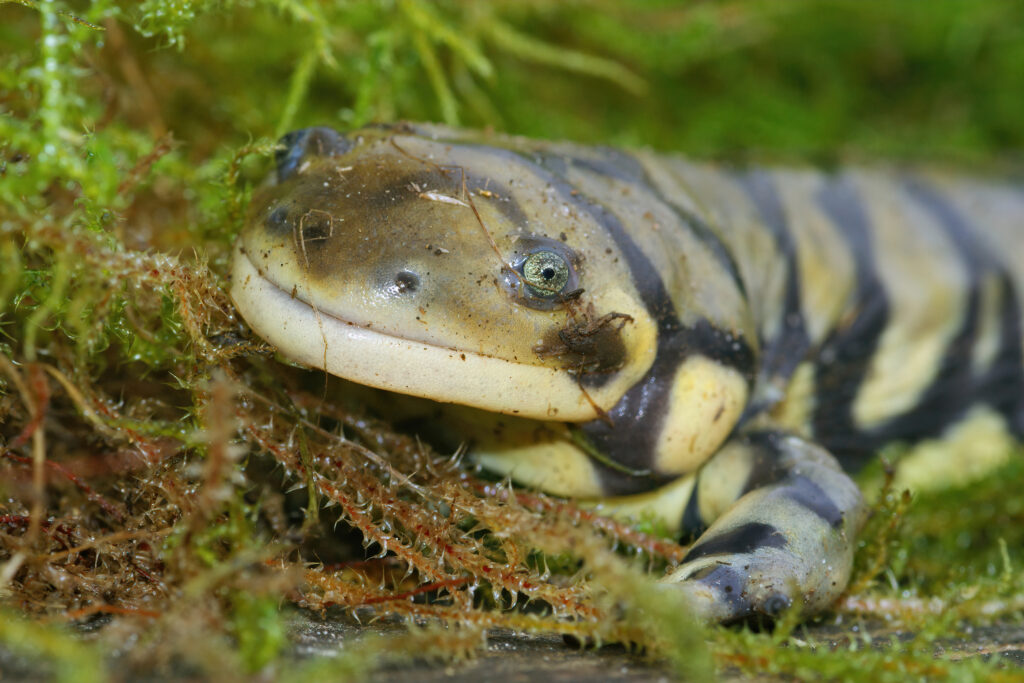
The western tiger salamander is found in every county in Colorado.
©iStock.com/Wirestock
A Night Hunter
While this salamander is found throughout the state, many Coloradans may rarely, if ever, see one due to its nocturnal nature. This salamander appears at night to hunt insects, frogs, snails, slugs, worms, fish, and other salamanders. It has even been known to cannibalize its own species if no other food source is available.
The western tiger salamander is among the largest of the salamanders. While most salamanders grow to around six inches, the western tiger salamander can reach lengths up to 14 inches.
The western tiger salamander is also the official amphibian of Kansas. Its relative, the eastern tiger salamander, is the state amphibian of Illinois.
2. State Animal: Rocky Mountain Bighorn Sheep
There are three subspecies of bighorn sheep, two of which are found in Colorado. The desert bighorn sheep can be found in places such as Colorado National Monument. This bighorn sheep was nearly extirpated from the region, but a small herd was reintroduced in 1979. These sheep have slowly made a comeback in this arid part of Colorado.
The other subspecies in the state is the one that was adopted as the official state animal in 1961: the Rocky Mountain bighorn sheep (Ovis canadensis canadensis).
Rocky Mountain bighorn sheep range throughout the Rockies from Alberta and British Columbia down to Arizona and New Mexico. Ewes typically stand about 34 inches tall at the shoulder and weigh around 135 pounds. Rams are significantly larger than ewes. They can stand up to 42 inches at the shoulder and weigh upwards of 300 pounds, making the Rocky Mountain bighorn sheep the largest wild sheep in North America.
The sheep are obviously named for their foreboding horns. The horns of a mature ram can weigh 30 pounds, which is 10% of its total body weight. In the fall, rams will battle one another with fierce headbutts. When the horns of two rams crash into one another at nearly 20 miles per hour, the sound can be heard nearly a mile away. This is all in a fight for dominance and breeding rights to sire the next generation of Rocky Mountain bighorn sheep.

Rocky Mountain Bighorn Sheep are the largest wild sheep in North America.
©iStock.com/Gary Gray
Threats to the Rocky Mountain Bighorn Sheep
Like all wild sheep, Rocky Mountain bighorns are targets for predators. Coyotes and mountain lions are among the primary predators that hunt these sheep. The Rocky Mountain bighorn’s main protection is their climbing agility. They can scale craggy cliffs so perilous that many predators will think twice about following them.
Predation is not the biggest challenge facing Rocky Mountain bighorn sheep, though. Habitat loss due to human development is always an issue, but bacterial pneumonia carried by domestic sheep began affecting wild sheep in the early 2010s. The disease can be fatal for Rocky Mountain bighorns, especially lambs. Non-native species, such as mountain goats, also carry pathogens that can be lethal for these wild sheep.
Conservationists and wildlife officials continue to work to preserve the majestic state animal of Colorado. These wild sheep belong in the Rocky Mountain highlands, and a lot of people are working hard to make sure they will be scaling those peaks for generations to come.
Colorado is the only state to feature the Rocky Mountain bighorn sheep as its state animal. The desert bighorn sheep is the state animal in Nevada.

Rocky Mountain bighorn sheep are made for the harsh elements of Colorado’s mountains.
©John Raptosh/Shutterstock.com
3. State Bird: Lark Bunting
The lark bunting (Calamospiza melanocorys) was named the state bird of Colorado in 1931, making it the first official animal symbol of the state.
Lark buntings are migratory birds. The flocks arrive in Colorado in April, signaling the arrival of spring. Historically, some Colorado farmers would wait to plant certain crops until they saw the return of the lark bunting. That was a sure sign that the spring planting season had arrived.
The lark bunting’s vocalizations, a mix of whistles and trills, are a welcome sound to Coloradans. It reminds them that the cold days of winter are giving way to the warmth of spring.
These birds are normally found in the plains regions to elevations up to 8,000 feet. Lark buntings remain in Colorado until September, when they head south ahead of the cold, snowy winter.
Female lark buntings are brown with white streaks. Interestingly, non-breeding males feature plumage very similar in color to females. However, during mating season, the male lark bunting’s appearance changes dramatically. Its plumage changes to black with distinct white wing patches, almost like the male is donning fine evening wear in an attempt to woo a fair lady.
While the lark bunting still proliferates in Colorado in the spring and summer, the population has significantly declined in recent decades. This is likely due to habitat loss. Pesticides have also caused a steep decline in insects such as grasshoppers, the primary food source for the lark bunting.

The male lark bunting puts on a black-and-white tuxedo-type look when wooing females.
©iStock.com/Nancy Strohm
4. State Fish: Greenback Cutthroat Trout
Colorado’s waterways once teemed with greenback cutthroat trout (Oncorhynchus clarki stomias). The population of this native trout was decimated through pollution from mining operations and the introduction of non-native fish species. The greenback cutthroat trout was declared extinct in 1937. However, after this declaration, there seemed to be hope when small populations were discovered in 1957, 1965, and 1970. Following these discoveries, an intensive conservation effort was launched, which included Colorado lawmakers’ designation of the greenback cutthroat trout as the official fish of the state in 1994.
However, in a cruel twist, it was later determined that these fish were not true greenback cutthroat trout at all but rather a similar-looking subspecies. A massive effort had been launched to save the wrong fish. It seemed as if the greenback cutthroat trout, now Colorado’s official state fish, was gone for good.
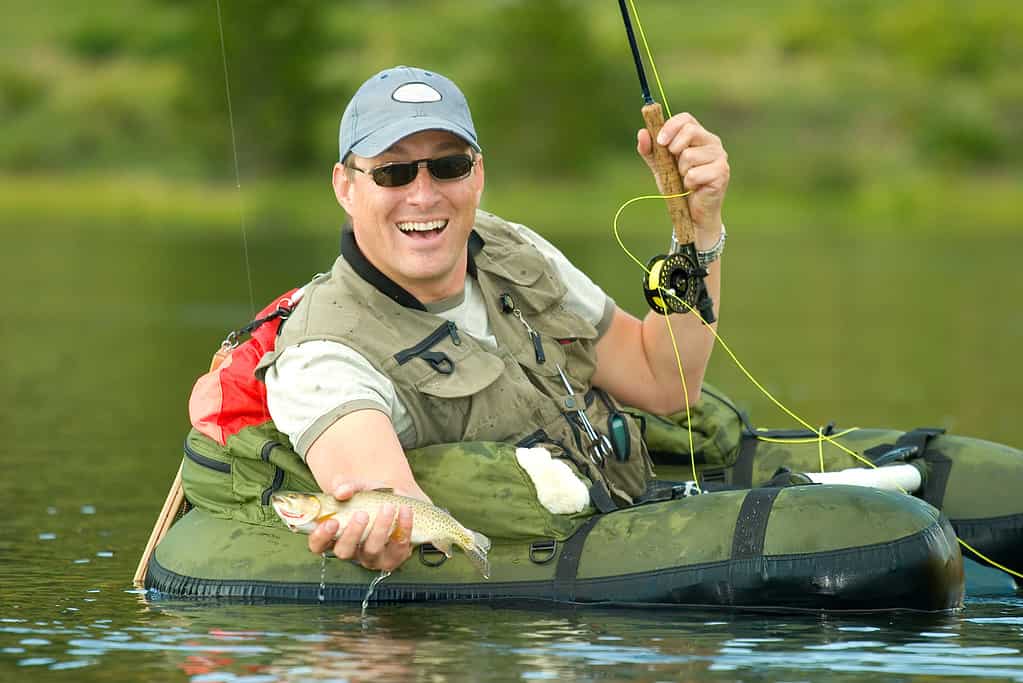
This Colorado flyfisherman proves the greenback cutthroat trout is NOT extinct!
©iStock.com/scottdharris
The “Extinct” Fish Was Found!
Then came an astounding discovery in 2012. A population of true greenback cutthroat trout was found in a small tributary of the Arkansas River known as Bear Creek. The fish occupied a 3.5-mile run in this creek located west of Colorado Springs. Interestingly, the fish is not native to this stretch of water. It seems that J.C. Jones, a homesteader and entrepreneur, was planning to build a hotel near Bear Creek in the 1870s. He stocked ponds on his homestead with fish, including greenback cutthroat trout, to build up his hotel’s appeal to anglers.
Some of these greenback cutthroat trout found their way from these ponds into Bear Creek. Thanks to impassable waterfalls, the fish were isolated and survived in these waters for over 140 years until they were discovered in 2012. Jones’ hotel never materialized, but he may have unwittingly saved this trout species from extinction.
After the discovery of this one remaining population of greenback cutthroat trout, Colorado Parks and Wildlife (CPW) launched what some viewed as a “Hail Mary” attempt to save this species. The fish were reintroduced into other Colorado streams, including those in Herman Gulch near Loveland. But it was all a waiting game to see if these reintroductions would take hold.
An Encouraging Sign
In 2022, CPW officials announced that the greenback cutthroat trout were reproducing on their own in the wild. It is an announcement that seemed utterly impossible just a few short years ago. While the signs are certainly encouraging, biologists caution that it will be quite a few years before there are fully restored greenback cutthroat trout populations throughout the state. The fish still has an uphill battle, which includes battling the aggressive and invasive brook trout for food and habitat.
The greenback cutthroat trout have the largest black spots of all the cutthroat trout species. It can grow up to 18 inches long. There are historical reports of fish up to ten pounds, but modern greenback cutthroat trout will likely weigh far less.
5. State Fossil: Stegosaurus
Colorado’s link to the Stegosaurus was discovered in the “Bone Wars” of the 1870s. These bulletless “wars” were fought between rival paleontologists. Edward Drinker Cope and Othniel Charles Marsh both launched fossil-finding expeditions in the early 1870s.
In an effort to outdo each other, the former friends resorted to petty jabs at one another in publications. Each attempted to cut off the funding of the other. They even resorted to criminal activity, such as theft and the destruction of bones. But the “Bone Wars” would reach their peak in 1877.
Oramel Lucas, a Colorado schoolteacher, was deer hunting in Garden Park when he stumbled across some fossilized bones. He contacted both Cope and Marsh, informing them of his discovery. The already-bitter rivalry grew even more heated as the two paleontologists jockeyed for position and access to the fossils, including two competing quarries.
In the end, the dispute between Cope and Marsh brought social and financial ruin to both men. But, in the midst of their disputes, some amazing discoveries were made, including Marsh’s discovery of the first Stegosaurus skeleton near Morrison, Colorado.
There are only six individual Stegosaurus skeletons on public display within the United States. One can be viewed at the Denver Museum of Nature & Science. The “Bone Wars” also gave way to what is now the Garden Park Fossil Area, managed by the Department of the Interior’s Bureau of Land Management.
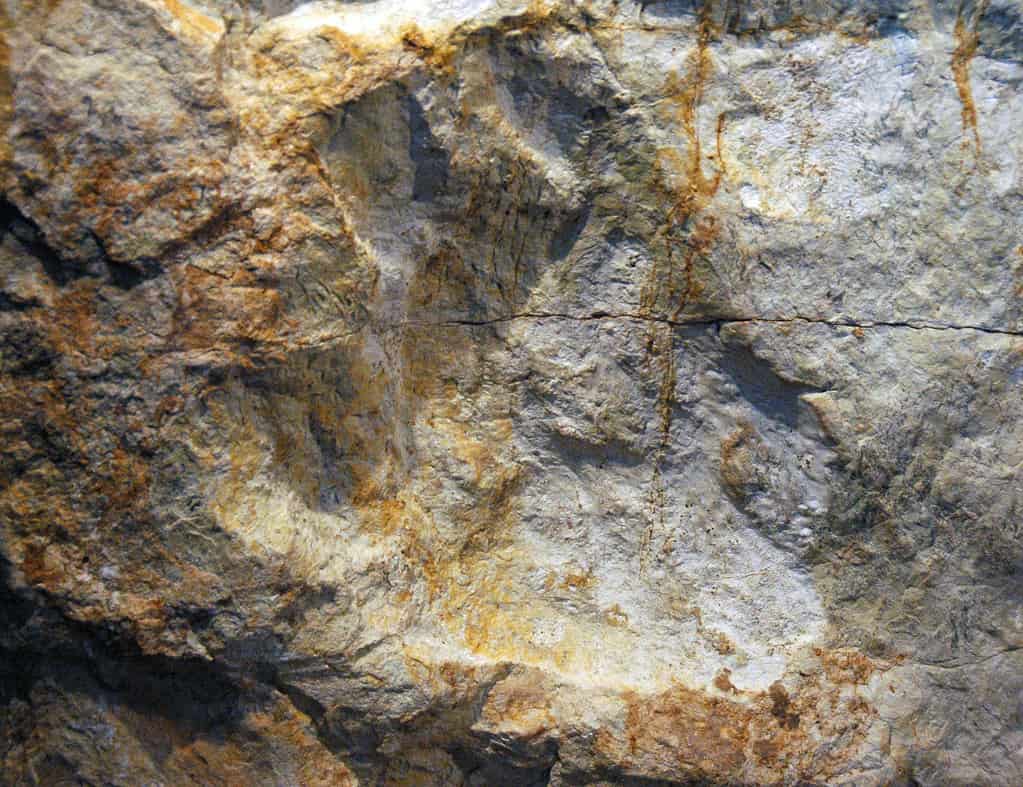
This Stegosaurus footprint was found in the fluvial sandstone of Morrison, Colorado.
©James St. John / CC BY 2.0 – License
The Push for Official State Status
Because of the discovery of the Stegosaurus in Colorado, a group of fourth-graders launched a two-year campaign to name it the official fossil of the state. Governor Richard D. Lamm (D) signed an executive order on April 28, 1982, which did exactly that.
The Stegosaurus is one of the most instantly recognizable dinosaurs. It featured up to 22 bony plates on its back. These plates were likely used for defense. They may have also helped regulate the dinosaur’s body temperature. The Stegosaurus also had a tail with four large spikes that it could swing to ward off any potential threat.
The Stegosaurus stood up to 14 feet tall overall, with a length of up to 30 feet. It’s believed the beast weighed upwards of 15,000 pounds. Despite its large size, the dinosaur had quite a small brain. Some have even labeled it the dumbest dinosaur ever, although that is probably incorrect.

This rendering reminds us that the Stegosaurus was one well-armored dinosaur!
©Daniel Eskridge/Shutterstock.com
6. State Insect: Colorado Hairstreak Butterfly
The Colorado hairstreak butterfly (Hypaurotis crysalus) is native to Colorado. This montane butterfly is typically found in the scrub oak ecosystems on both sides of the Continental Divide at elevations of 6,500-9,000 feet.
When the butterfly is at rest, it closes its wings. The color of the wings’ underside is a dull gray with white stripes. When the wings are opened, though, the butterfly reveals its vivid purple color with black and orange edge coloring.
Along with Colorado, this hairstreak butterfly is found in Arizona, New Mexico, Utah, and southern Wyoming.
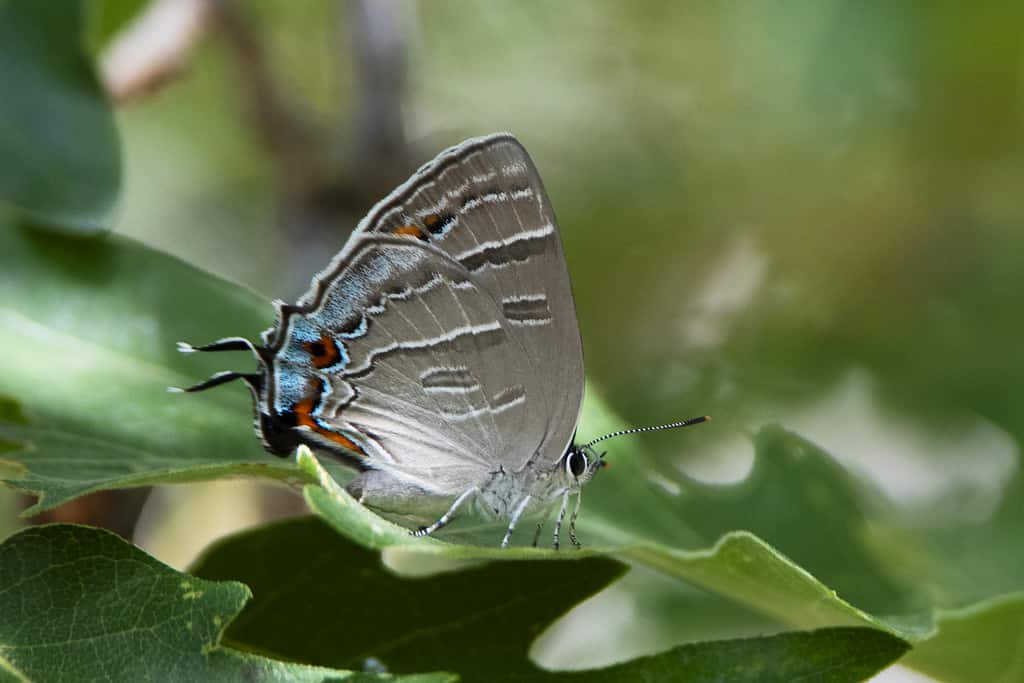
The underside of the Colorado Hairstreak Butterfly’s wings is gray.
©Chris Quirin / CC BY 4.0 – License
The beauty of the insect and its native Colorado range prompted Melinda Terry’s fourth-grade class at Wheeling Elementary School to lobby lawmakers to adopt the butterfly as the official state insect. There was a bit of debate, with some lawmakers preferring the honey bee over this hairstreak butterfly to represent the state. The Colorado hairstreak eventually won enough support, and it was named the official state insect of Colorado on April 17, 1996.

The top side of the Colorado Hairstreak Butterfly’s wings are stunning purple.
©Megan McCarty / CC BY-SA 3.0 – License
7. State Pets: Rescue Dogs and Cats
Colorado was the 12th state to name an official state pet. Rescue dogs and cats were named the state pets of Colorado in 2013.

Rescue dogs and cats are the official state pets of Colorado.
©Parilov/Shutterstock.com
Colorado school children lobbied for the designation, but the bill was not without controversy. Some legislators preferred a purebred dog to be the official state pet representative, as numerous other states have done.
Others argued that by designating shelter animals as the state’s official pets, legislators were essentially creating a designation for a business transaction. It was also argued that some animals in the state’s shelters are not from Colorado in the first place.
But the bill won enough support to pass and it was signed into law by Governor Hickenlooper on May 13, 2013. At the signing, which took place at a Denver animal shelter, the governor said the bill, “helps schoolchildren learn about the legislative process.” He went on to say, “These pets become a huge part of people’s lives.” The governor’s dog, Skye, was also in attendance at the signing. The governor’s family adopted Skye from a shelter.

Colorado schoolchildren lobbied for rescue dogs and cats to be named the state pets of the state.
©Giordano66/Shutterstock.com
8. State Reptile: Western Painted Turtle
The western-painted turtle (Chrysemys picta belIii) was selected as the state animal by two of Jay Baichi’s fourth-grade classes (2007-2008). The students learned that the state lacked an official reptile, so they began researching reptiles that were native to the state. They decided on the western-painted turtle as the best reptilian representative of Colorado since it is a common sight in the state’s ponds and lakes. Their efforts were rewarded when Governor Bill Ritter (D) signed HB 08-1017 on March 18, 2008, naming the western-painted turtle the official state reptile of Colorado.
Painted turtles are the most common aquatic turtle species in North America. The subspecies of the turtle, such as the eastern, southern, and western painted turtles, are largely differentiated only by geography and aesthetics. In truth, these turtle subspecies vary only slightly from one another.
All painted turtles eat small fish, aquatic insects, and vegetation. Males grow to about eight inches long, while females can grow up to one foot in length. It is common for these turtles to live up to 30 years in the wild, though some have lived as long as 50 years.
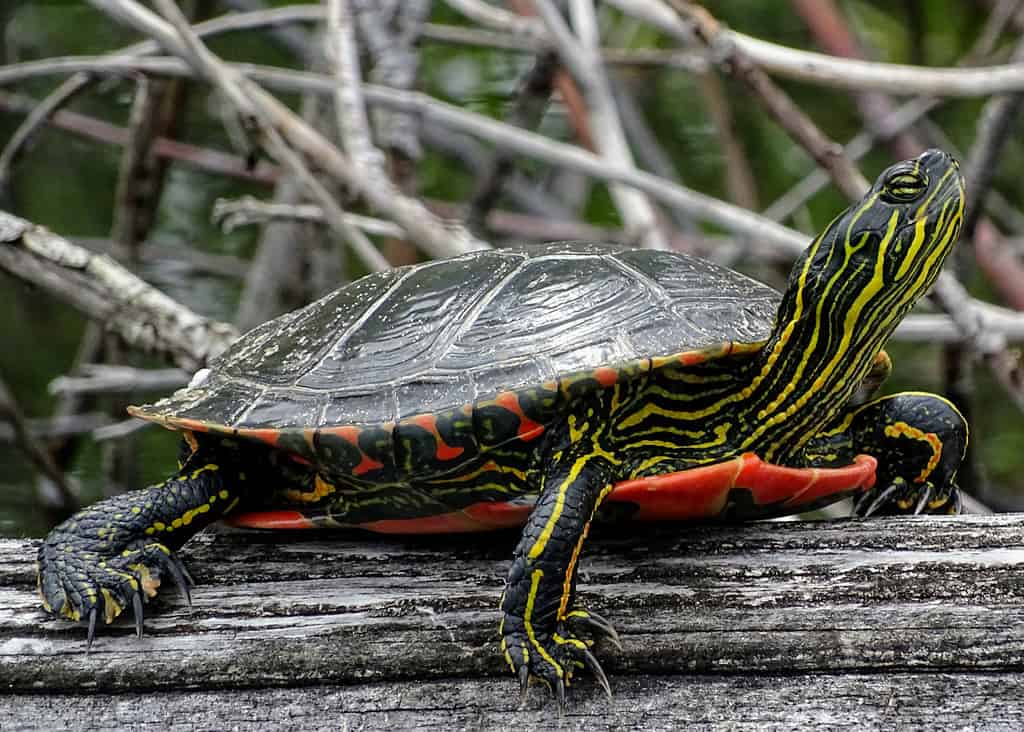
The western-painted turtle can be found near Colorado ponds and lakes.
©iStock.com/Dave Acheson Photography
The photo featured at the top of this post is © iStock.com/Gary Gray
Thank you for reading! Have some feedback for us? Contact the AZ Animals editorial team.






